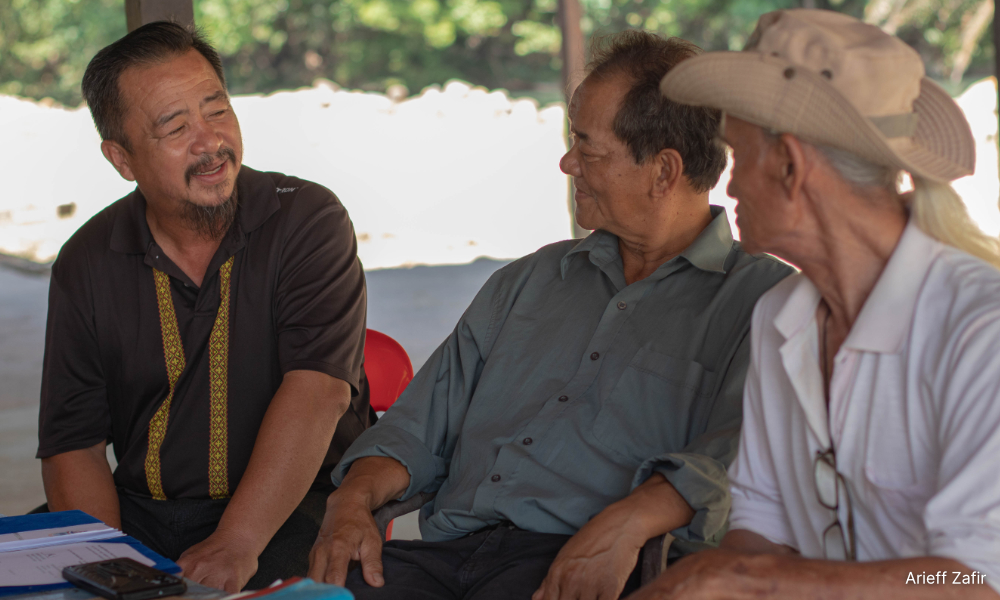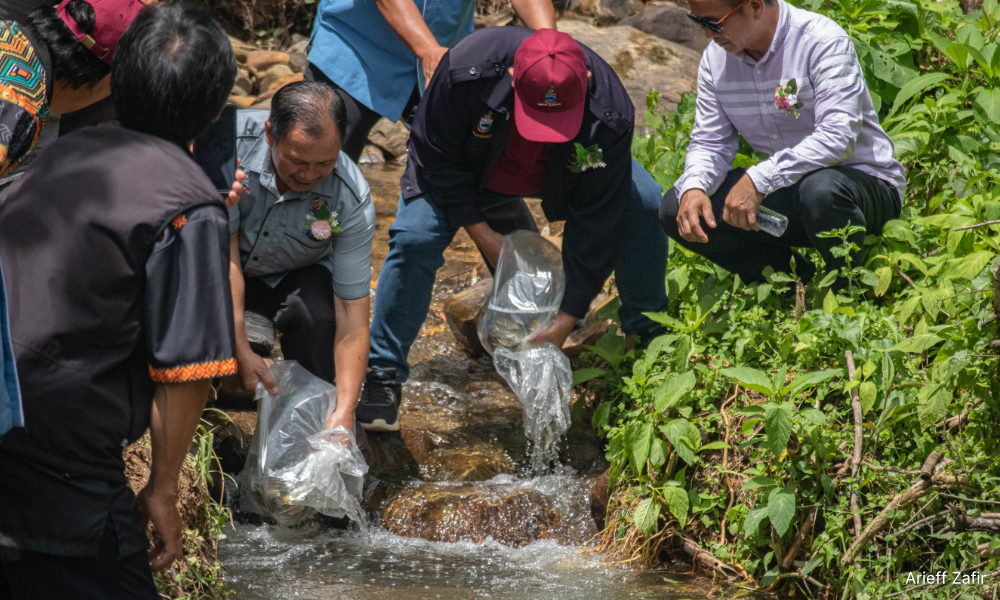The Moyog River flows steadily and constantly through Kampung Notoruss in Penampang on Sabah’s west coast.
As you dip your feet into the water, fish gently drift towards you and you can’t help but observe how the river’s rocky path from the other side of the bridge transforms into a calm, clear green stretch - the protected red zone of the village’s Tagal system.
This village was the first to revive the traditional river conservation system in the 1990s, said Tagal committee secretary Florina Glorius. Since 2013, it has become an ecotourism spot.
 The Moyog River along the Tagal Tinopikon of Kampung Notoruss has been cleaned and become one of the famous ecotourist spots in Penampang
The Moyog River along the Tagal Tinopikon of Kampung Notoruss has been cleaned and become one of the famous ecotourist spots in PenampangHowever, balancing river conservation with tourism can be challenging.
“We need to have our rules. Otherwise, people would throw rubbish all over - including the visitors,” said Florina.
Tagal, or bombon, is an indigenous community-based approach to managing fisheries resources - a practice that is being revived today with the support of the Fisheries Department in Sabah.
Despite broader issues related to community consensus, interdepartmental challenges, and other environmental concerns, Tagal, a collaboration model between local indigenous communities and the Sabah state government, shows how indigenous knowledge can address contemporary environmental issues and conserve rivers.
Changing rainfall patterns
One challenge for this conservation system is the changing climate. For instance, although fish often return after major rainfall, changing rainfall patterns can affect freshwater ecosystems.
 Village Tagal committee chairperson Jahim Singkui looks over at the red zone in his village in Kampung Tambatuon after a night of heavy rain
Village Tagal committee chairperson Jahim Singkui looks over at the red zone in his village in Kampung Tambatuon after a night of heavy rain“It gets hard, the rivers are unlike before,” Gidius Gonsuin, also known as Sami, solemnly observed.
Having formerly worked at the Fisheries Department himself in Penampang, the 65-year-old chairperson of the Tagal committee of Kampung Babagon recently saw his village inundated by its worst floods in early July this year, severely impacting fish populations.
 Chairperson of the Tagal committee at Kampung Babagon Gidius Gonsuin points at the Moyog River
Chairperson of the Tagal committee at Kampung Babagon Gidius Gonsuin points at the Moyog RiverTagal committee members in various villages in Sabah said excessive rain and floods can also cause soil erosion while keeping ecotourists away.
“When there’s no flooding, this entire place is filled with people,” said Sami.
Floods have also devastated the Tagal infrastructure, said Jurry Foo, an associate professor of geography at Universiti Malaysia Sabah, who has researched the traditional conservation system. “When the floods come, all of their infrastructures (at the Tagal site) go with it! They get swept away by the floods.”
 Fish always return to their ‘homes’ in the Wariu River despite floods at the nearby Kamping Tabulion Ulu
Fish always return to their ‘homes’ in the Wariu River despite floods at the nearby Kamping Tabulion UluInvasive species
The introduction of non-native fish species can seriously undermine Tagal’s efforts to conserve native fish populations, said Pacos Trust programme coordinator Gordon John Thomas.
Pacos Trust is a community-based organisation supporting indigenous communities in Sabah.
“Fish like tilapia can be very invasive - they’ll turn your river into a desert. There’ll be no other fish,” he said.
“We need to give more technical support, and the government, too, has been providing native fish seedlings.
”For example, in Kampung Bolotikan in Papar, Pacos Trust supported communities in practising catch-and-release, where they release only native fish species like the ikan pelian into the rivers,” he said.
He said Tagal systems can also be undermined by upstream pollution in designated rivers, and the villagers may not be able to stop it on their own.
“If there’s pollution upriver, they don’t have any jurisdiction to enforce,” said Gordon, who is of Dusun Tatana ancestry.
“But still, the most important is the monitoring, enforced by the community itself because they know the area. So they’re the ones who will be the frontline, instead of the government.”
 The Paramat River passing through Kamping Melangkap Tiong is now awash ikan pelian thanks to the Tagal system
The Paramat River passing through Kamping Melangkap Tiong is now awash ikan pelian thanks to the Tagal systemNavigating bureaucracy
Managing the Tagal system also requires navigating intercommunity relationships and government bureaucracy, which can sometimes create friction and hinder progress.
According to some villagers and Fisheries Department officials, issues can arise due to a lack of communication or consensus between government departments such as the Environment Department, Irrigation and Drainage Department, and the Lands and Surveys Department.
Hamdan Jaini, of Marakau village in Ranau, said that even though Tagal is supported by the Fisheries Department and formed under the Sabah Inland Fisheries and Aquaculture Enactment 2003, other departments do not recognise it.
“We had issues with land near our river being claimed by other individuals or departments, even though it is not in accordance with the law… even though our river has already received Tagal status for over a decade and is an ecotourism spot,” he said, adding that this was the biggest obstacle for his Tagal committee.
He pointed out that the land next to the river had been left aside due to ownership issues and that we were the first outsiders to step foot on it that day.
“Sometimes, these issues influence and divide our village as well,” he lamented.
“Other times, other researchers come into the village to exploit our traditional knowledge. If there’s no perceived importance of Tagal, whether among the community members or the government departments, then this can hinder proper collaboration.”
Intergovernmental woes
The Tagal committees from villages like Marakau want better cooperation with all governmental agencies and researchers involved in environmental management, not just the Fisheries Department.
Hamdan also believed that all the departments need to recognise the work that the Fisheries Department does with the community.
“It is because of the sincerity of the community members and officials, such as Ramlie Raiman from Ranau district’s Fisheries Department, that we’re now able to access better rights,” he said.
His committee’s secretary Mohd Jamil added that legislative improvements could also support the Tagal system by addressing potential issues, such as when the river passes through individual land.
“As long as there is a department that does not recognise the Fisheries Department as the body that enforces Tagal, this will be an issue.”
 Penampang Fisheries Department officer Tony Anus (left) chatting with Tagal committee members Gigius Gonsuin and William Joti Johnioh at their village in Kampung Babagon
Penampang Fisheries Department officer Tony Anus (left) chatting with Tagal committee members Gigius Gonsuin and William Joti Johnioh at their village in Kampung BabagonModel for the region
The Sabah Fisheries Department believes that its approach has been successful in resolving interdepartmental issues so far.
Bernedeth Joseph, who runs the department’s Tagal unit, said that when Tagal village committees enter into a five-year memorandum of understanding with the department, they will involve other relevant departments to ensure comprehensive support and collaboration.
This collaborative approach strengthens the system’s effectiveness and serves as a model that could inspire other communities, both within Malaysia and in neighbouring countries, to adopt similar practices for river and environmental conservation.
 The Moyog River that passes through Kampung Babagon in Penampang has been revived and survived a major flood in July 2024 due to the Tagal system
The Moyog River that passes through Kampung Babagon in Penampang has been revived and survived a major flood in July 2024 due to the Tagal system“In Sarawak, they have their version called Tagang. Peninsular Malaysians are also visiting us to learn about Tagal,” said Domius Talindap, who heads the Kampung Melangkap Tagal committee.
“However, what’s most important is that we empower the community to be part of the conservation efforts, and legally recognise adat (custom), like how we do it here.”
For example, Tagal fines are not just imposed at the village committee level but are enforced by the native courts (mahkamah anak negeri) in Sabah’s legal system, which applies the customary law whenever there is a breach.
The Sabah Native Court supports the practice of sogit (a kind of fine or compensation) according to customary beliefs to prevent a breach of any customs made by its people.
Expanding to other natural resources
Challenges aside, Tagal’s success in river conservation has prompted communities and government departments to consider expanding the concept towards other natural resources, such as forests.
“Protection of the forests through Tagal uses the same concept,” said Adrian Banie Lasimbang of the indigenous-led social enterprise Tonibung.
“Tagal is not just limited to rivers, it can expand to include watershed areas. It is an indigenous concept that extends to other natural resources.”
With increasing interest, more villages across Sabah are establishing Tagal systems in their rivers.
In Tudan near Tuaran, Ropina Yunduk, 60, is enthusiastic about the prospects.
“I am optimistic that Tagal will help our village take care of the fish biodiversity,” she said. “I hope the Tagal system brings improvements for us village folk as well.”
It has also attracted 51-year-old Roger Angon of Kampung Tudan, a village in Ranau district of about 1,000 people. He recently launched the system in his village and is now leading the Tagal committee there.
“Ranau district is known for Tagal. So when I saw this, I got interested and asked around and the department agreed. So that was that!”
 Fish seedlings are being released into the river by newly appointed village Tagal committee chairperson Roger Angon alongside Ranau district head of Native Court Muhasip Ruman as part of the launch of Kampung Tudan’s Tagal system
Fish seedlings are being released into the river by newly appointed village Tagal committee chairperson Roger Angon alongside Ranau district head of Native Court Muhasip Ruman as part of the launch of Kampung Tudan’s Tagal systemBrimming with excitement at the official opening in July, Roger joined the Fisheries Department representatives to release fish seedlings into his village’s river.
There was an air of excitement as community members and officers observed and later celebrated together over lunch coupled with a karaoke session.
“I feel very happy because there’s a lot of support from my village,” said Roger, who is of Dusun Liwan ancestry.
“It’s clear because Tagal ensures that our rivers are clean, and it supports our community.”
LIANI MK is a journalist whose work focuses on land and indigenous rights, culture, and migration. This article was produced with the support of Internews’ Earth Journalism Network grant for indigenous environmental journalists.
Part 1: How indigenous practices revive Sabah’s ecosystem, one river at a time
Part 2: Community empowerment lynchpin of Sabah river conservation system









 English (US) ·
English (US) ·